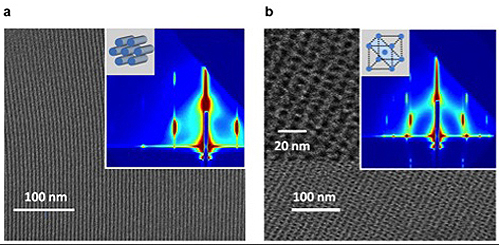 Abstract art or nanoparticle-polymer material at work?[/caption] Researchers at the University of Akron have developed materials capable of self-assembling into nano-scale structures that could, in turn, be used to build ultra-light, super-efficient integrated circuits. The material is a liquid solution called a "giant surfactant" that combines nanoparticles with polymers into a material capable of self-assembling large molecules into patterns dictated by the nanoparticles. The result is a liquid or thin film that, when applied to semiconductors, forms a lithographic pattern that can be controlled at the molecular level and shaped into circuits far smaller than the 22 nanometers that is the current state of the art in integrated circuit design. Giant surfactants could self-assemble into circuits less than half that diameter, vastly increasing the number of circuits that can be packed into a single processor, which increases the complexity and computing power of the circuits as well. "The IT industry wants microchips that are as small as possible so that they can manufacture smaller and faster devices," according to a statement from lead researcher Stephen Z.D. Cheng, dean of the University of Akron's College of Polymer Science and Polymer Engineering. "This is exactly what we are pursuing—self-assembling materials that organize at smaller sizes, say, less than 20 or even 10 nanometers." Shrinking the diameter of a single circuit allows for a huge leap in complexity and power, but using molecules that self-assemble into nanopatterns may be more significant because it could change the way integrated circuits are manufactured and allow the assembly of new structures that could deliver more power with far less weight and lower power requirements, researchers found. The material, which can be applied either as a liquid or thin film, can also be designed to create polymers with different molecular architectures and compositions at different locations on a processor, or to deliver different performance characteristics using the same source material. The result could be a class of materials that would become "a versatile platform for engineering nanostructures with sub-10-nm feature sizes," according to the paper describing the material, which was published in the Proceedings of the National Academy of Sciences. Self-assembling molecules applied as liquids could also vastly change the process of manufacturing integrated circuits from one based mostly on electrical and mechanical engineering into a less energy-intensive process based on chemical engineering and nanotechnology instead. Cheng's team and the University of Akron have already applied for a patent on the material and process for creating it. Image: PNAS
Abstract art or nanoparticle-polymer material at work?[/caption] Researchers at the University of Akron have developed materials capable of self-assembling into nano-scale structures that could, in turn, be used to build ultra-light, super-efficient integrated circuits. The material is a liquid solution called a "giant surfactant" that combines nanoparticles with polymers into a material capable of self-assembling large molecules into patterns dictated by the nanoparticles. The result is a liquid or thin film that, when applied to semiconductors, forms a lithographic pattern that can be controlled at the molecular level and shaped into circuits far smaller than the 22 nanometers that is the current state of the art in integrated circuit design. Giant surfactants could self-assemble into circuits less than half that diameter, vastly increasing the number of circuits that can be packed into a single processor, which increases the complexity and computing power of the circuits as well. "The IT industry wants microchips that are as small as possible so that they can manufacture smaller and faster devices," according to a statement from lead researcher Stephen Z.D. Cheng, dean of the University of Akron's College of Polymer Science and Polymer Engineering. "This is exactly what we are pursuing—self-assembling materials that organize at smaller sizes, say, less than 20 or even 10 nanometers." Shrinking the diameter of a single circuit allows for a huge leap in complexity and power, but using molecules that self-assemble into nanopatterns may be more significant because it could change the way integrated circuits are manufactured and allow the assembly of new structures that could deliver more power with far less weight and lower power requirements, researchers found. The material, which can be applied either as a liquid or thin film, can also be designed to create polymers with different molecular architectures and compositions at different locations on a processor, or to deliver different performance characteristics using the same source material. The result could be a class of materials that would become "a versatile platform for engineering nanostructures with sub-10-nm feature sizes," according to the paper describing the material, which was published in the Proceedings of the National Academy of Sciences. Self-assembling molecules applied as liquids could also vastly change the process of manufacturing integrated circuits from one based mostly on electrical and mechanical engineering into a less energy-intensive process based on chemical engineering and nanotechnology instead. Cheng's team and the University of Akron have already applied for a patent on the material and process for creating it. Image: PNAS Spray-On Nano-Material Could Outdo Intel's Best
[caption id="attachment_11257" align="aligncenter" width="499"]  Abstract art or nanoparticle-polymer material at work?[/caption] Researchers at the University of Akron have developed materials capable of self-assembling into nano-scale structures that could, in turn, be used to build ultra-light, super-efficient integrated circuits. The material is a liquid solution called a "giant surfactant" that combines nanoparticles with polymers into a material capable of self-assembling large molecules into patterns dictated by the nanoparticles. The result is a liquid or thin film that, when applied to semiconductors, forms a lithographic pattern that can be controlled at the molecular level and shaped into circuits far smaller than the 22 nanometers that is the current state of the art in integrated circuit design. Giant surfactants could self-assemble into circuits less than half that diameter, vastly increasing the number of circuits that can be packed into a single processor, which increases the complexity and computing power of the circuits as well. "The IT industry wants microchips that are as small as possible so that they can manufacture smaller and faster devices," according to a statement from lead researcher Stephen Z.D. Cheng, dean of the University of Akron's College of Polymer Science and Polymer Engineering. "This is exactly what we are pursuing—self-assembling materials that organize at smaller sizes, say, less than 20 or even 10 nanometers." Shrinking the diameter of a single circuit allows for a huge leap in complexity and power, but using molecules that self-assemble into nanopatterns may be more significant because it could change the way integrated circuits are manufactured and allow the assembly of new structures that could deliver more power with far less weight and lower power requirements, researchers found. The material, which can be applied either as a liquid or thin film, can also be designed to create polymers with different molecular architectures and compositions at different locations on a processor, or to deliver different performance characteristics using the same source material. The result could be a class of materials that would become "a versatile platform for engineering nanostructures with sub-10-nm feature sizes," according to the paper describing the material, which was published in the Proceedings of the National Academy of Sciences. Self-assembling molecules applied as liquids could also vastly change the process of manufacturing integrated circuits from one based mostly on electrical and mechanical engineering into a less energy-intensive process based on chemical engineering and nanotechnology instead. Cheng's team and the University of Akron have already applied for a patent on the material and process for creating it. Image: PNAS
Abstract art or nanoparticle-polymer material at work?[/caption] Researchers at the University of Akron have developed materials capable of self-assembling into nano-scale structures that could, in turn, be used to build ultra-light, super-efficient integrated circuits. The material is a liquid solution called a "giant surfactant" that combines nanoparticles with polymers into a material capable of self-assembling large molecules into patterns dictated by the nanoparticles. The result is a liquid or thin film that, when applied to semiconductors, forms a lithographic pattern that can be controlled at the molecular level and shaped into circuits far smaller than the 22 nanometers that is the current state of the art in integrated circuit design. Giant surfactants could self-assemble into circuits less than half that diameter, vastly increasing the number of circuits that can be packed into a single processor, which increases the complexity and computing power of the circuits as well. "The IT industry wants microchips that are as small as possible so that they can manufacture smaller and faster devices," according to a statement from lead researcher Stephen Z.D. Cheng, dean of the University of Akron's College of Polymer Science and Polymer Engineering. "This is exactly what we are pursuing—self-assembling materials that organize at smaller sizes, say, less than 20 or even 10 nanometers." Shrinking the diameter of a single circuit allows for a huge leap in complexity and power, but using molecules that self-assemble into nanopatterns may be more significant because it could change the way integrated circuits are manufactured and allow the assembly of new structures that could deliver more power with far less weight and lower power requirements, researchers found. The material, which can be applied either as a liquid or thin film, can also be designed to create polymers with different molecular architectures and compositions at different locations on a processor, or to deliver different performance characteristics using the same source material. The result could be a class of materials that would become "a versatile platform for engineering nanostructures with sub-10-nm feature sizes," according to the paper describing the material, which was published in the Proceedings of the National Academy of Sciences. Self-assembling molecules applied as liquids could also vastly change the process of manufacturing integrated circuits from one based mostly on electrical and mechanical engineering into a less energy-intensive process based on chemical engineering and nanotechnology instead. Cheng's team and the University of Akron have already applied for a patent on the material and process for creating it. Image: PNAS
 Abstract art or nanoparticle-polymer material at work?[/caption] Researchers at the University of Akron have developed materials capable of self-assembling into nano-scale structures that could, in turn, be used to build ultra-light, super-efficient integrated circuits. The material is a liquid solution called a "giant surfactant" that combines nanoparticles with polymers into a material capable of self-assembling large molecules into patterns dictated by the nanoparticles. The result is a liquid or thin film that, when applied to semiconductors, forms a lithographic pattern that can be controlled at the molecular level and shaped into circuits far smaller than the 22 nanometers that is the current state of the art in integrated circuit design. Giant surfactants could self-assemble into circuits less than half that diameter, vastly increasing the number of circuits that can be packed into a single processor, which increases the complexity and computing power of the circuits as well. "The IT industry wants microchips that are as small as possible so that they can manufacture smaller and faster devices," according to a statement from lead researcher Stephen Z.D. Cheng, dean of the University of Akron's College of Polymer Science and Polymer Engineering. "This is exactly what we are pursuing—self-assembling materials that organize at smaller sizes, say, less than 20 or even 10 nanometers." Shrinking the diameter of a single circuit allows for a huge leap in complexity and power, but using molecules that self-assemble into nanopatterns may be more significant because it could change the way integrated circuits are manufactured and allow the assembly of new structures that could deliver more power with far less weight and lower power requirements, researchers found. The material, which can be applied either as a liquid or thin film, can also be designed to create polymers with different molecular architectures and compositions at different locations on a processor, or to deliver different performance characteristics using the same source material. The result could be a class of materials that would become "a versatile platform for engineering nanostructures with sub-10-nm feature sizes," according to the paper describing the material, which was published in the Proceedings of the National Academy of Sciences. Self-assembling molecules applied as liquids could also vastly change the process of manufacturing integrated circuits from one based mostly on electrical and mechanical engineering into a less energy-intensive process based on chemical engineering and nanotechnology instead. Cheng's team and the University of Akron have already applied for a patent on the material and process for creating it. Image: PNAS
Abstract art or nanoparticle-polymer material at work?[/caption] Researchers at the University of Akron have developed materials capable of self-assembling into nano-scale structures that could, in turn, be used to build ultra-light, super-efficient integrated circuits. The material is a liquid solution called a "giant surfactant" that combines nanoparticles with polymers into a material capable of self-assembling large molecules into patterns dictated by the nanoparticles. The result is a liquid or thin film that, when applied to semiconductors, forms a lithographic pattern that can be controlled at the molecular level and shaped into circuits far smaller than the 22 nanometers that is the current state of the art in integrated circuit design. Giant surfactants could self-assemble into circuits less than half that diameter, vastly increasing the number of circuits that can be packed into a single processor, which increases the complexity and computing power of the circuits as well. "The IT industry wants microchips that are as small as possible so that they can manufacture smaller and faster devices," according to a statement from lead researcher Stephen Z.D. Cheng, dean of the University of Akron's College of Polymer Science and Polymer Engineering. "This is exactly what we are pursuing—self-assembling materials that organize at smaller sizes, say, less than 20 or even 10 nanometers." Shrinking the diameter of a single circuit allows for a huge leap in complexity and power, but using molecules that self-assemble into nanopatterns may be more significant because it could change the way integrated circuits are manufactured and allow the assembly of new structures that could deliver more power with far less weight and lower power requirements, researchers found. The material, which can be applied either as a liquid or thin film, can also be designed to create polymers with different molecular architectures and compositions at different locations on a processor, or to deliver different performance characteristics using the same source material. The result could be a class of materials that would become "a versatile platform for engineering nanostructures with sub-10-nm feature sizes," according to the paper describing the material, which was published in the Proceedings of the National Academy of Sciences. Self-assembling molecules applied as liquids could also vastly change the process of manufacturing integrated circuits from one based mostly on electrical and mechanical engineering into a less energy-intensive process based on chemical engineering and nanotechnology instead. Cheng's team and the University of Akron have already applied for a patent on the material and process for creating it. Image: PNAS 
